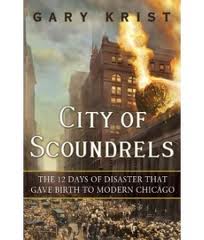Urban Violence And The City of Scoundrels
Does history happen or happen to you? Historians like to focus on turning points, on dramatic crises, on changes that interrupt continuities. In City of Scoundrels, Gary Krist looks at twelve sweltering days in the summer of 1919 in Chicago.
The scoundrels were mostly Chicago politicians, especially “Big Bill” Thompson, Chicago’s mayor. Recently reelected due to a split field, Thompson was much more interested in campaigning and deal-making than governing. Thompson was poorly equipped to deal with the dramatic events that hot July.
A blimp caught on fire and crashed into a Chicago office building, a girl disappeared engaging the populace in a city-wide hunt until her killer confessed, a series of bombings targeting the black population swept the city, Chicago’s transit workers went on strike, and finally, a race riot erupted after when five young black men went swimming and their makeshift raft crossed into a “white” area. One of the young men drowned after being hit on the head from a rock thrown by a racist on the beach. His was the first death and thirty-seven more would follow in what is now known as the Chicago Race Riots of 1919. Wide swaths of the city were wrecked and burned as gangs of whites and blacks fought each other with clubs, bricks, and guns.
Where was the government? Thompson and Illinois’s governor, Frank Lowden, played politics with the idea of calling out the militia.
From this maelström, Krist argues, a modern Chicago was born. The city recovered and began a period of growth and expansion. True enough, but the real message of his Chicago history is its insights into the struggle between violence and governance in city life.
For most Americans living in cities, violence was an ever-present threat. It was no imaginary fear. Any general review of urban life across the United States reveals common themes: growth, dynamic economics, and mobs wreaking havoc. Race conflict often drove the violence, with class and labor issues not far behind. Every major metropolis in America has wrestled with urban violence at least one point in its history before the 1970s. Many cities have had multiple riots. Bombers and arsonists terrorized people in the 1800s and 1900s, but we did not yet call them terrorists. American identity was forged in revolutionary city violence – the Boston Massacre and the Boston Tea Party.
We no longer seem to fear urban mobs. Krist’s book helps us remember that urban violence is an important part of our heritage.
David Potash